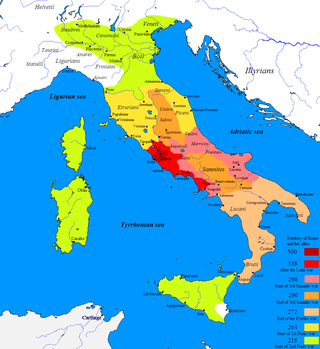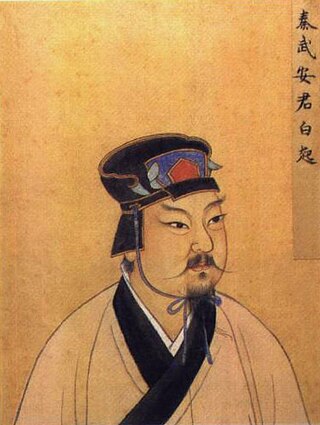Related Research Articles

Year 264 BC was a year of the pre-Julian Roman calendar. At the time it was known as the Year of the Consulship of Caudex and Flaccus. The denomination 264 BC for this year has been used since the early medieval period, when the Anno Domini calendar era became the prevalent method in Europe for naming years.
During the 290s BC, Hellenistic civilization begins its emergence throughout the successor states of the former Argead Macedonian Empire of Alexander the Great, resulting in the diffusion of Greek culture throughout the Levant and advances in science, mathematics, philosophy, etc. Meanwhile, the Roman Republic is embroiled in war against the Samnites, the Mauryan Empire continues to thrive in Ancient India, and the Kingdom of Qin in Ancient China, the one which in the future will conquer its adversaries and unite China, begins to emerge as a significant power during the Warring States period.
This article concerns the period 279 BC – 270 BC.
This article concerns the period 269 BC – 260 BC.
Year 260 BC was a year of the pre-Julian Roman calendar. At the time it was known as the Year of the Consulship of Asina and Duilius. The denomination 260 BC for this year has been used since the early medieval period, when the Anno Domini calendar era became the prevalent method in Europe for naming years.
Year 257 BC was a year of the pre-Julian Roman calendar. At the time it was known as the Year of the Consulship of Regulus and Blasio. The denomination 257 BC for this year has been used since the early medieval period, when the Anno Domini calendar era became the prevalent method in Europe for naming years.
Year 259 BC was a year of the pre-Julian Roman calendar. At the time it was known as the Year of the Consulship of Scipio and Florus. The denomination 259 BC for this year has been used since the early medieval period, when the Anno Domini calendar era became the prevalent method in Europe for naming years.
Year 262 BC was a year of the pre-Julian Roman calendar. At the time it was known as the Year of the Consulship of Valerius and Otacilius. The denomination 262 BC for this year has been used since the early medieval period, when the Anno Domini calendar era became the prevalent method in Europe for naming years.
Year 263 BC was a year of the pre-Julian Roman calendar. At the time it was known as the Year of the Consulship of Mesella and Crassus. The denomination 263 BC for this year has been used since the early medieval period, when the Anno Domini calendar era became the prevalent method in Europe for naming years.
Year 276 BC was a year of the pre-Julian Roman calendar. At the time it was known as the Year of the Consulship of Gurges and Clepsina. The denomination 276 BC for this year has been used since the early medieval period, when the Anno Domini calendar era became the prevalent method in Europe for naming years.
Year 275 BC was a year of the pre-Julian Roman calendar. At the time it was known as the Year of the Consulship of Dentatus and Caudinus. The denomination 275 BC for this year has been used since the early medieval period, when the Anno Domini calendar era became the prevalent method in Europe for naming years.
Year 278 BC was a year of the pre-Julian Roman calendar. At the time it was known as the Year of the Consulship of Luscinus and Papus. The denomination 278 BC for this year has been used since the early medieval period, when the Anno Domini calendar era became the prevalent method in Europe for naming years.

Year 279 BC was a year of the pre-Julian Roman calendar. At the time it was known as the Year of the Consulship of Publius Sulpicius Saverrio and Publius Decius Mus. The denomination 279 BC for this year has been used since the early medieval period, when the Anno Domini calendar era became the prevalent method in Europe for many years.
Year 280 BC was a year of the pre-Julian Roman calendar. At the time it was known as the Year of the Consulship of Laevinus and Coruncanius. The denomination 280 BC for this year has been used since the early medieval period, when the Anno Domini calendar era became the prevalent method in Europe for naming years.
Year 294 BC was a year of the pre-Julian Roman calendar. At the time it was known as the Year of the Consulship of Megellus and Regulus. The denomination 294 BC for this year has been used since the early medieval period, when the Anno Domini calendar era became the prevalent method in Europe for naming years.
Year 293 BC was a year of the pre-Julian Roman calendar. At the time it was known as the Year of the Consulship of Cursor and Maximus. The denomination 293 BC for this year has been used since the early medieval period, when the Anno Domini calendar era became the prevalent method in Europe for naming years.
Year 292 BC was a year of the pre-Julian Roman calendar. At the time it was known as the Year of the Consulship of Gurges and Scaeva. The denomination 292 BC for this year has been used since the early medieval period, when the Anno Domini calendar era became the prevalent method in Europe for naming years.
Year 291 BC was a year of the pre-Julian Roman calendar. At the time it was known as the Year of the Consulship of Megellus and Brutus. The denomination 291 BC for this year has been used since the early medieval period, when the Anno Domini calendar era became the prevalent method in Europe for naming years.

Bai Qi, also known as Gongsun Qi (公孫起), was a Chinese military general of the Qin state during the Warring States period. Born in Mei, Bai Qi served as the commander of the Qin army for more than 30 years, being responsible for the deaths of over one million, earning him the nickname Ren Tu. According to the Shiji, he seized more than 73 cities from the other six hostile states, and to date no record has been found to show that he suffered a single defeat throughout his military career. He is regarded by Chinese folklore as one of the four Greatest Generals of the Late Warring States period, along with Li Mu, Wang Jian, and Lian Po; he is also remembered as the most fearsome amongst the four.

King Zhaoxiang of Qin, or King Zhao of Qin (秦昭王), born Ying Ji (Chinese: 嬴稷, was the king of Qin from 306 BC to 251 BC. He was the son of King Huiwen and younger brother of King Wu.
References
- ↑ Qian, Sima. Records of the Grand Historian, Section: Basic Annals of Qin, Section: Bai Qi.